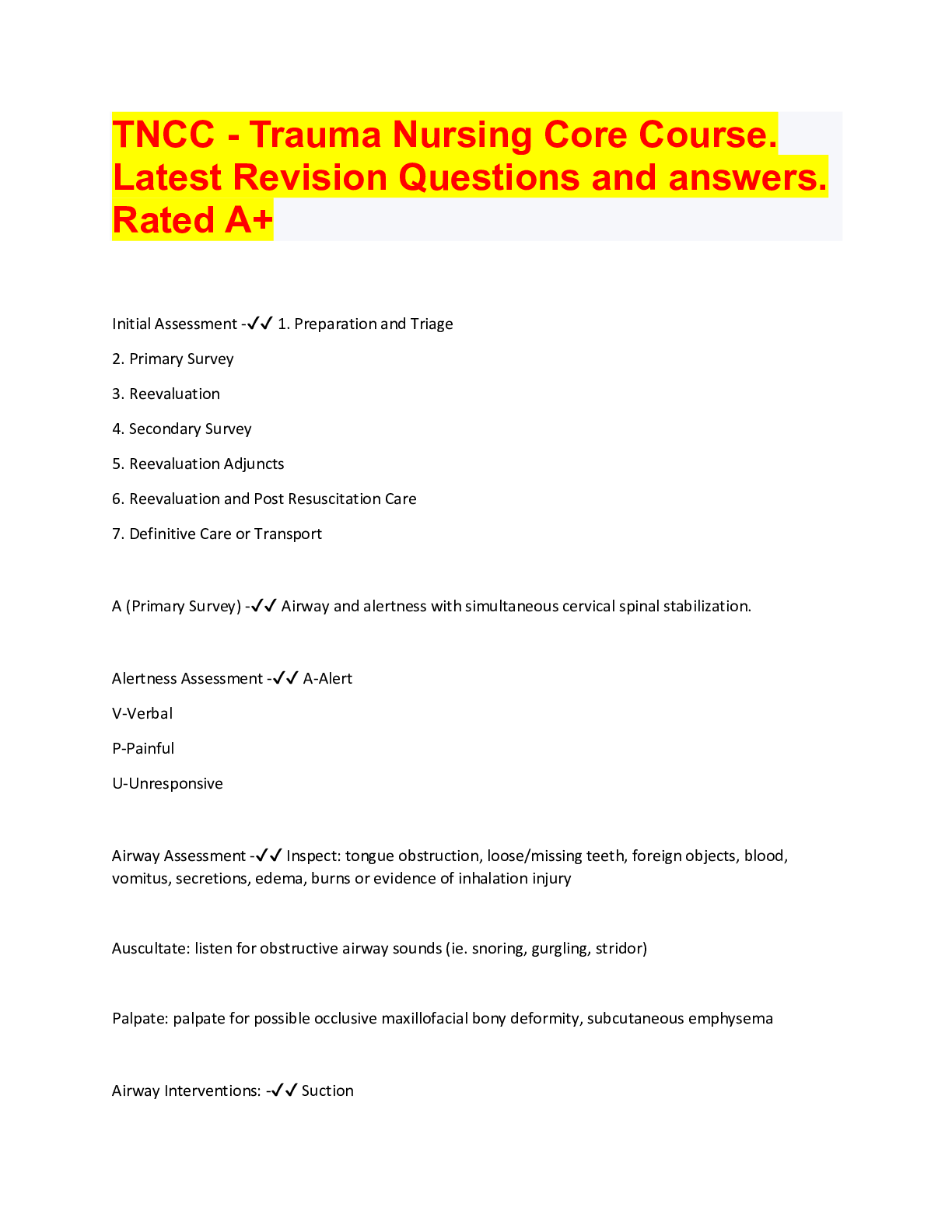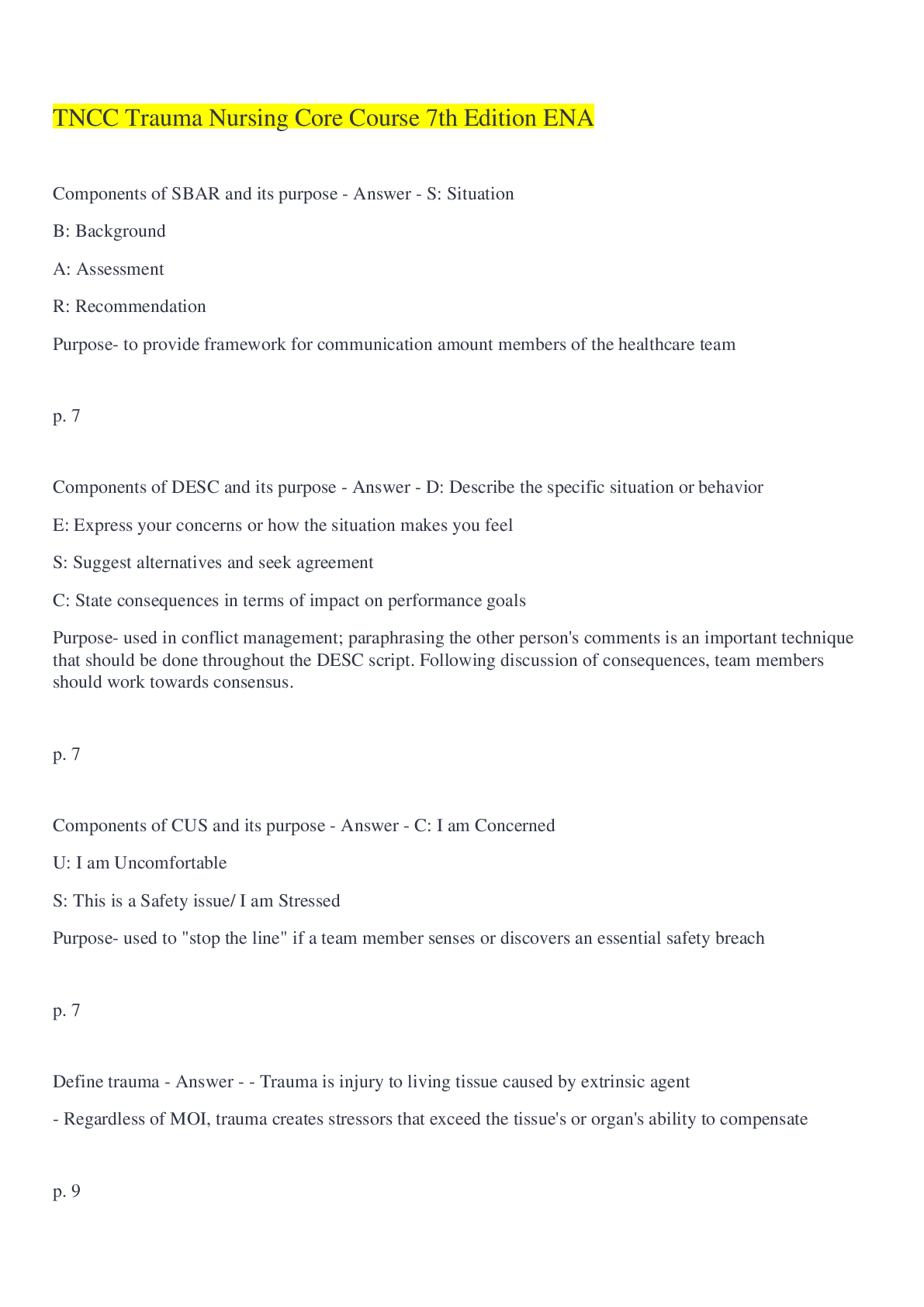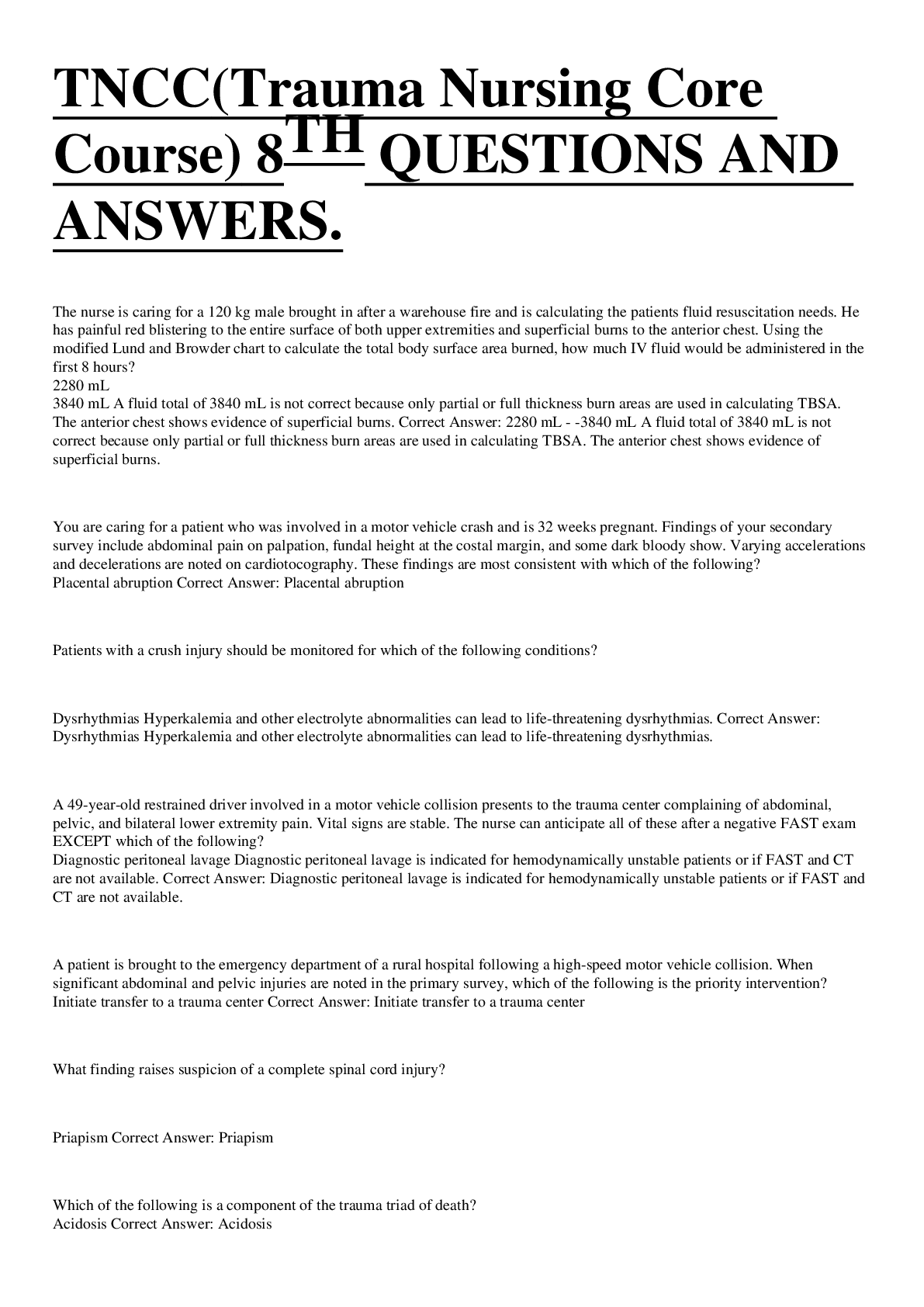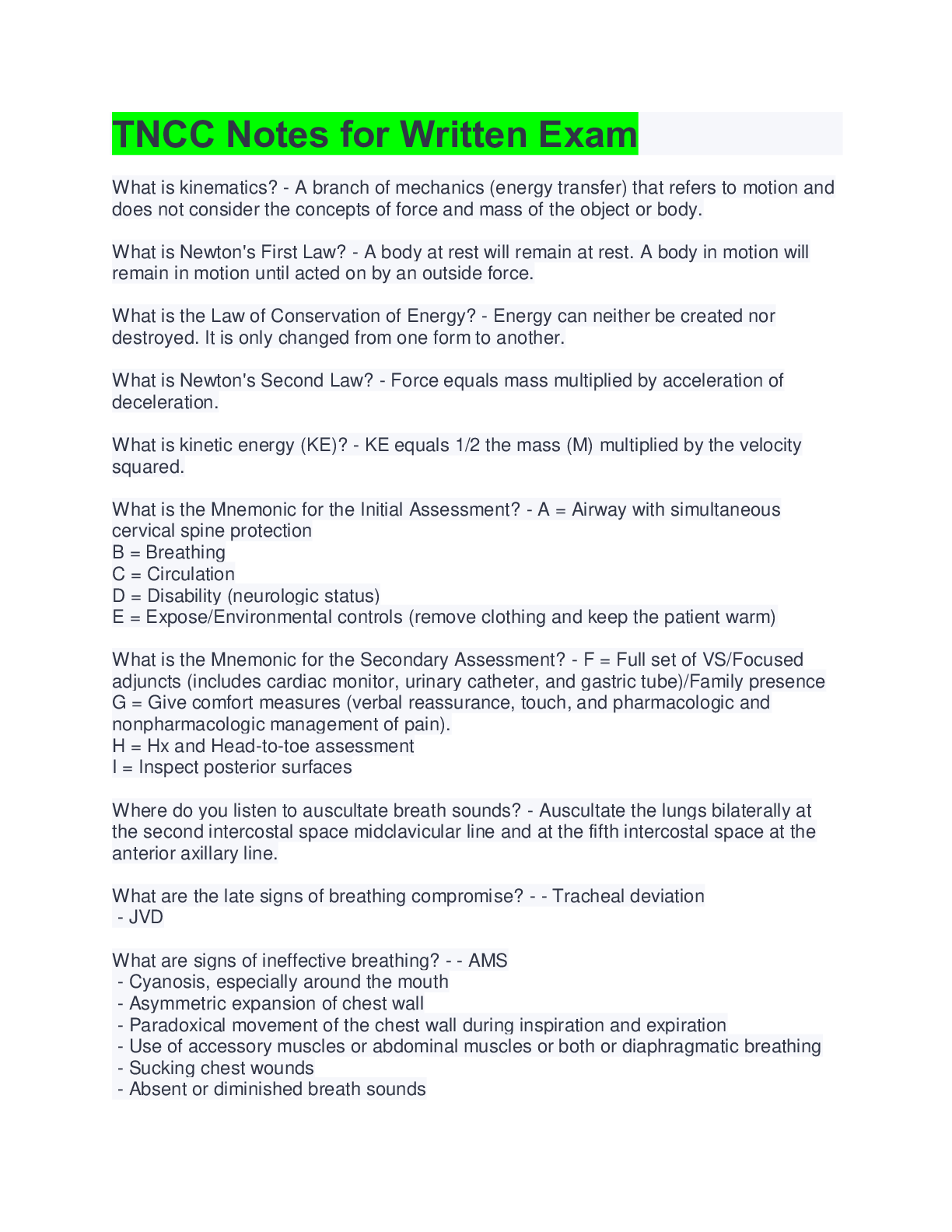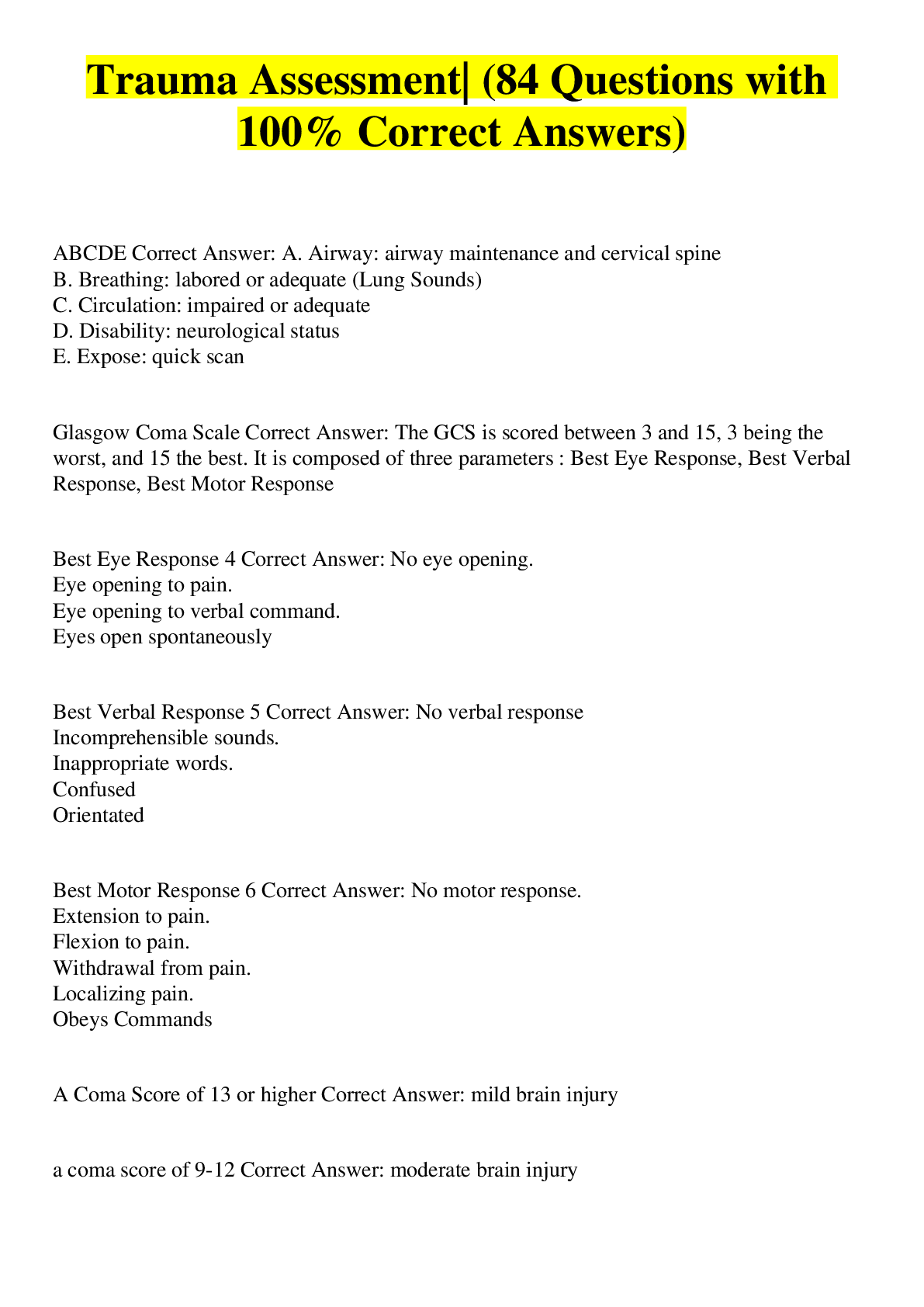*NURSING > QUESTIONS & ANSWERS > TNCC - Trauma Nursing Core Course Exam 2022 Study Guide (All)
TNCC - Trauma Nursing Core Course Exam 2022 Study Guide
Document Content and Description Below
1. Preparation and Triage 2. Primary Survery (ABCDE) with resuscitation adjuncts (F,G) 3. Reevaluation (consideration of transfer) 4. Secondary Survey (HI) with reevaluation adjuncts 5. Reevaluati... on and post resuscitation care 6. Definitive care of transfer to an appropriate trauma nurse - ✔✔Initial Assessment 1. A- airway and Alertness with simultaneous cervical spinal stabilization 2. B- breathing and Ventilation 3. circulation and control of hemorrhage 4. D - disability (neurologic status) 5. F - full set of vitals and Family presence 6. G - Get resuscitation adjuncts L- Lab results (arterial gases, blood type and crossmatch) M- monitor for continuous cardiac rhythm and rate assessment N- naso or orogastric tube consideration O- oxygenation and ventilation analysis: Pulse oxygemetry and end-tidal caron dioxide (ETC02) monitoring and capnopgraphy H- History and head to toe assessment I- Inspect posterior surfaces - ✔✔ABCDEFGHI Before the arrival of the pt - ✔✔When should PPE be placed: Pt is at hospital in the right amount of time, right care, right trauma facility, right resources - ✔✔Safe Care: Uncontrolled Hemorrhage - ✔✔Major cause of preventable death:reorganize care to C-ABC - ✔✔If uncontrolled hemorrhage .. Used at the beginning of the initial assessment 1. A Alert. If the pt is alert he or she will be able to maintain his or her airway once it is clear. 2. V responds to verbal stimuli responds to pain. If the patient needs verbal stimulation to respond, an airway adjunct may be needed to keep the tongue from obstructing the airway. 3. P responds to pain. If the pt. responds only to pain, he or she may not be able to maintain his or her airway adjunct may need to be placed while further assessment is made to determine the need for intubation. 4. U Unresponsive. If the pt. is unresponsive, announce it loudly to the team and direct someone to chk in the pt is pulseless while assessing if the cause of the problem is the airway. - ✔✔Airway and AVPU: ask pt to pen his or her mouth - ✔✔While assessing airway the patient is alert and responds to verbal stimuli you should.. jaw thrust maneuver to open airway and assess for obstruction. If pt has a suspected csi, the jaw thrust procedure should be done by two providers. One provider can maintain c-spine and the other can perform the jaw thrust maneuver. - ✔✔While assessing airway pt is unable to open mouth, responds only to pain, or is unresponsive you should.. 1. The tongue obstructing the airway 2. loose or missing teeth 3. foreign objects 4. blood, vomit, or secretions' 5. edema 6. burns or evidence of inhalation injury Auscultiate or listen for: 1. Obstructive airway sounds such as snoring or gurgling2. Possible occlusive maxillofacial bony deformity 3. Subcutaneous emphysema - ✔✔Inspect the mouth for: 1. Check the presence of adequate rise and fall of the chest with assisted ventilation 2. Absence of gurgling on auscultation over the epigastrium 3. Bilateral breath sounds present on auscultation 4. Presence of carbon dioxide (CO2) verified by a CO2 device or monitor - ✔✔If the pt has a definitive airway in what should you do? 1. Suction the airway 2, Use care to avoid stimulating the gag reflex 3. If the airway is obstructed by blood or vomitus secretions, use a rigid suction device If foreign body is noted, remove it carefully with forceps or another appropriate method - ✔✔If Airway is not patent 1. Apnea 2. GCS 8 or less 3. Maxillary fractures 4. Evidence of inhalation injury (facial burns) 5. Laryngeal or tracheal injury or neck hematoma 6. High risk of aspiration and patients inability to protect the airway 7. Compromised or ineffective ventilation - ✔✔Following conditions might require a definitive airway Breathing: To assess breathing expose the chest: 1. Inspect for a. spontaneous breathing b. symmetrical rise and fall c. depth, pattern, and rate of respiration d. signs of difficulty breathing such as accessory muscle usee. skin color (normal, pale, flushed, cyanotic) f. contusions, abrasions, deformities (flail chest) g. open pneumothoraces (sucking chest wounds) h. JVD i. signs of inhalation injury (singed nasal hairs, carbonaceous sputum) - ✔✔B tracheal deviation and jvd - ✔✔Late signs of tension pneumo: 1. equal breath sounds bilaterally at the second intercostal space midclavicular line and the bases for fifth intercostal space at the axillary line - ✔✔Auscultate the chest for: 1. bony fractures and possible rib fractures, which may impact ventilation 2. palpate for crepitus 3. subcutaneous emphysema which may be a sign for a pneumothorax 4. soft tissue injury - ✔✔Palpate the chest for 1. open the airway, use jaw thrust 2. insert an oral airway 3. assist ventilations with a bag mask 4. prepare for definitive airway - ✔✔If breathing is absent.. trauma its need early supplemental oxygen, start with 15 mL O2 and titrate oxygen delivery. - ✔✔Oxygen on trauma patients Circulation and Control of Hemorrhage Inspect first for any uncontrolled bleeding Skin colorpalpate for central pulses - carotid and femoral - rate, rhythm, and strength Skin temp: cool, diaphoretic, or warm and dry - ✔✔C [Show More]
Last updated: 2 years ago
Preview 1 out of 13 pages
.png)
Buy this document to get the full access instantly
Instant Download Access after purchase
Buy NowInstant download
We Accept:

Reviews( 0 )
$15.00
Can't find what you want? Try our AI powered Search
Document information
Connected school, study & course
About the document
Uploaded On
Jul 13, 2022
Number of pages
13
Written in
Seller

Reviews Received
Additional information
This document has been written for:
Uploaded
Jul 13, 2022
Downloads
0
Views
102
.png)











